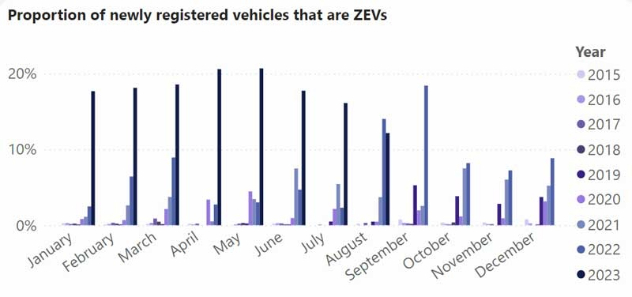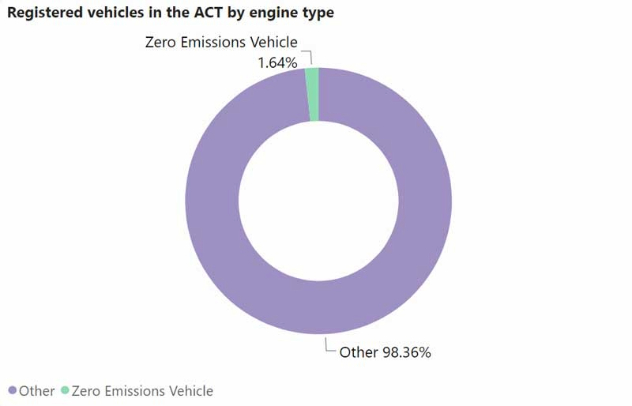ACT electric vehicle subsidies and incentives

Since May 2021, the Australian Capital Territory has offered generous incentives for zero-emission vehicle (ZEV) buyer and owners, setting a benchmark for other states to achieve Australia's net zero target.
ZEVs include any vehicle that produces no tailpipe carbon emission, including battery electric vehicles (BEVs) and (hydrogen) fuel cell electric vehicles (FCEVs).
Related: What are the different types of EV?
New or used zero-emissions passenger vehicles were eligible for two years' free registration under the scheme which ran until 30 June 2024. Zero-emissions vehicles purchased before 24 May 2021 were not eligible, however do receive a 20 per cent ongoing reduction on registration fees.
With free registration for newly registered ZEVs
now finished on 1 July 2024, ZEV owners in the ACT can get reduced registration fee estimates by using this tool.
ACT reforms at a glance
- Two years free registration for newly purchased new and used Zero Emission Vehicles (ZEV) from 24 May, 2021 until 30 June, 2024 in ACT (this was previously a 20 per cent discount).
- From 1 July, 2024, the ACT government will cease free registration for ZEVs and transition to an emissions-based registration system instead of weight-based registration fees. This means that owners of ZEVs will benefit from reduced registration fees.
- From 1 July 2024, if you are an owner of a ZEV in the ACT you can get an estimate of your new registration fee by entering your number plate into this tool.
- New and used ZEVS purchased after 1 August, 2022 are also eligible for a stamp duty exemption. From 1 July, 2023 this also includes used PHEVs (plug-in-hybrids) and hybrids.
- Interest-free loans from $2000 up to $15,000 are still available for the purchase of ZEVs as part of the Sustainable Household Scheme, repayable over up to 10 years.
What the NRMA thinks
The ACT has some of the most generous incentives in the country for electric vehicles, which include stamp duty exemptions and interest-free loans. These additional savings in registration fees of a couple hundred dollars each year, for two years, is another good incentive to purchase a zero emissions vehicle.
The NRMA supports the ACT Government's announcement and strongly encourages all Governments to reform motoring taxes to make electric vehicles cheaper for Australian motorists to purchase, thus encouraging their take up. We want lower motoring costs, improved vehicle choice for consumers, and better health and environmental outcomes to support our future generations.
ACT’s shift to EVs
When the new EV incentives were first announced in 2021, Chief Minister of the ACT Andrew Barr said transport accounts for around 60 per cent of the ACT’s greenhouse gas emissions, of which 70 per cent are from private vehicles.
Chief Minister of the ACT Andrew Barr said transport accounts for around 60 per cent of the ACT’s greenhouse gas emissions, of which 70 per cent are from private vehicles.
“Reducing transport emissions in the ACT is an essential step to achieving a sustainable, resilient future for our Territory and to reach our goal of net zero emissions by 2045,” said Mr Barr.
ACT Greens leader and Energy and Emissions Reduction Minister Shane Rattenbury said the “obvious’ next step for the Territory was to make the shift to electric vehicles.
“Our community understands the need for practical and meaningful action to address climate change. With our 100 per cent renewable electricity supply, the obvious next step is to shift to electric vehicles as they offer a zero-emissions transport solution,” Mr Rattenbury said.
Since the introduction of the incentives, the ACT has seen a considerable increase in uptake of electric vehicles. According to data on the ACT government transport website, uptake jumped from less than 5 per cent of new car sales in 2021 to around 20 per cent in 2023.

While this means that the ACT is leading the way in the transition to electric vehicles in Australia, in total fleet terms this means that the number of cars on the road in the ACT that are fully electric still sits at less than 2 per cent - a total of 5,432 vehicles registered.

Charts source: climatechoices.act.gov.au
Join

to enjoy these benefits when you’re in Newcastle
to enjoy these benefits when you’re in Newcastle
You might also like


















